News
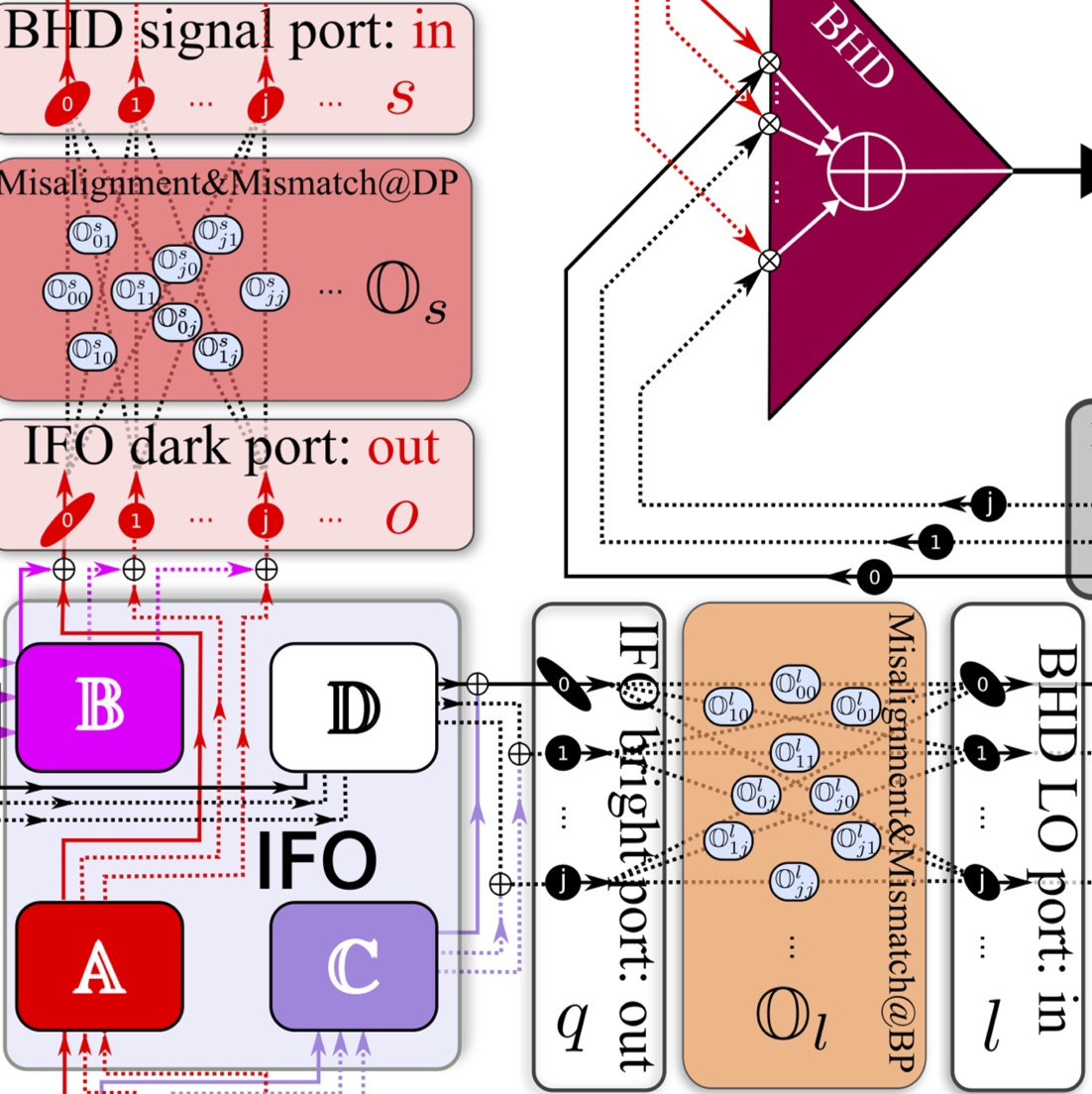
06/03/2017: New article published on implementing balanced homodyne readout in suspended interferometers
In the context of the practical implementation of balanced homodyne readout (BHD) in suspended interferometers with realistic (i.e. imperfect) optics, we develop a full framework for analysing the the static higher order optical modes (HOM) occurring in the BHD paths related to the misalignment or mode matching at the input and output ports of the laser interferometer. In addition, we investigated the noise coupling mechanisms from beam jitter, i.e. time varying HOM contributions with the example of Glasgow Sagnac speed meter experiment. This work (Physical Review D vol. 95 article 062001) paves the way for technical design studies of future upgrades to gravitational wave detectors featuring balanced homodyne readout.
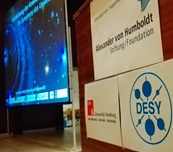
24/2/2017: Humboldt Science and Music Festival
Today, Stefan gives a public evening lecture in Hamburg on the discovery of gravitational waves. Stefan's lecture will be followed by a classical concert. Science meets music, sponsored by the Humboldt Foundation and DESY and free for several hundreds of interested guests.
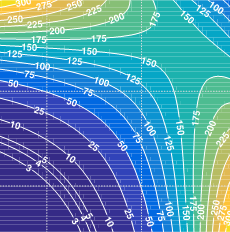
3/2/2017: New article on a new type of quantum speed meter
In our most recent article we have developed a new type of speed meter that offers significant practical advantages compared to previous speed meter types. The polarisation circulation speedmeter use left- and right- circular polarized light to realise a Sagnac like readout of the test masses, where all light passes in short succession through both arm resonators. This configuration offers a significantly reduced complexity of the interferometer, higher feasibility due to lower optical loss and ultimately the best quantum noise reduction. This speed meter configuration can be added to currently-used GW observatories as an incremental upgrade, thus maximising observation time. Finally, it offers the possibility of in-situ switching between position and speed measurement, thus adding flexibility and minimising risk.
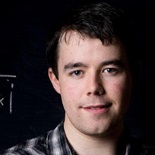
16/01/2017: Welcome back for an old group member
We are very happy to welcome back a former student from within the ERCvspeed meter group, Dr Sean Leavey. Sean has accepted a postdoc position in the group following a six-month SUPA-funded industrial knowledge transfer placement at Razorbill Instruments Ltd where he designed a new product, a USB-controllable high voltage power supply to actuate the company's existing line of cryogenic strain cells. His immediate priorities within the group will be the careful assembly and installation of the suspensions to hang the 100g test masses in the vacuum system
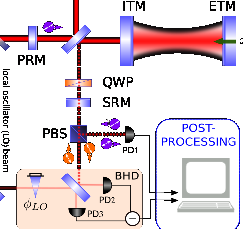
6/1/2017: Using Einstein-Podolsky-Rosen entanglement to realise speed meters
In our most recent paper we have developed a new type of speed meter: The Einstein-Podolsky-Rosen (EPR) speed meter is working with two orthogonal linear polarisation modes to create two independent readouts of the interferometer test masses, featuring very different storage times in the arm cavities. The difference in storage time is achieved by the polarisation experiencing a relative phase shift of /2 leading to the signal recycling cavity acting as resonant sideband extract for one polarisation and signal recycling for the orthogonal polarisation. If the output channels of these two position meters are combined carefully by an additional beam splitter, a position and a speed channel can be created from the common and differential mode outputs. The influence of the position meter-like back action force can be cancelled using the EPR approach facilitated by measuring the amplitude quadrature of the beam splitter common output correlated with the back action noise.
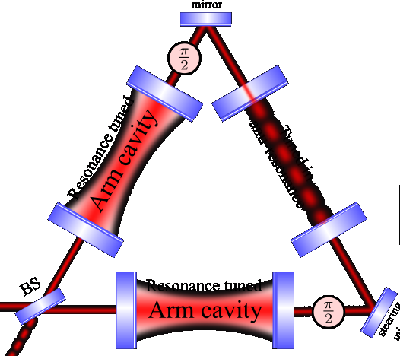
20/12/2016: New Article Published - A speed meter design for the Einstein Telescope
A new speed meter article has just been published. In this article we develop a speed meter scheme that is especially applicable to the triangular footprint of the Einstein Telescope. This configuration does not only provide the usual improvement of quantum noise that is common to all speed meter types, but we also show that by eliminating the requirement for maximally-reflecting cavity end mirrors with correspondingly-thick multi-layer coatings, coating noise can be reduced by a factor of approximately 2.2 compared to conventional interferometers.
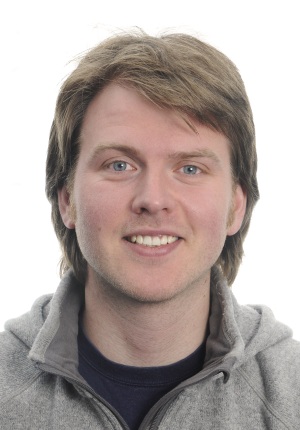
06/10/2016: Scottish Government Buddy Scheme
Dr Christian Graef was selected as a participant in the Scottish Government Buddy Scheme, a joint project of IOP Scotland and the Scottish Government. Starting in November 2015, the aim of this scheme has been to put scientists and teachers in contact with civil servants, to expand the participants' professional networks. Government organisations represented were SEPA, Marine Scotland and Transport Scotland. Here is a short feature article about the scheme.
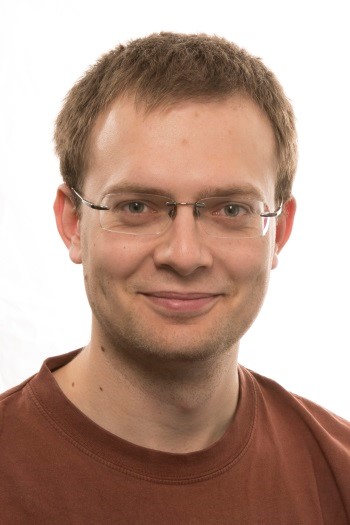
1/10/2016: New PhD Student
Peter Dupej has joined the speed meter group as a PhD student after completing his master degree in Theoretical Physics at the University of Glasgow. During his undergraduate years he participated in a summer internship and a 4th year project within IGR, followed by a 5th year project in the speed meter group. Building on this past experience, Peter will now analyse the quantum noise of newly proposed topologies of gravitational wave detectors based on the speed meter interferometer.
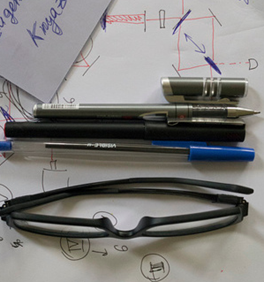
21/6/2016: Welcome to the 2nd International speed meter workshop
We are glad that we can welcome to Scotland the leading scientists in the world of quantum noise and QND techniques for our 2nd international speedmeter workshop. Attendees include amongst others Prof Khalili (Moscow), Prof McClelland (Canberra), Prof Chen (Caltech), Prof Vyatchanin (Moscow), Dr Lueck (Max Planck Institute), Prof Freise (Birmingham), Dr Miao (Birmingham) and Prof Barnett (Glasgow). Impressions from this workshop can be found in this gallery.
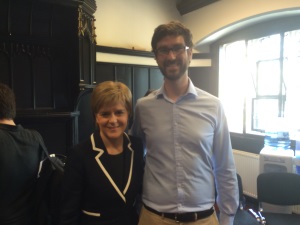
03/06/2016: Meeting Nicola Sturgeon
The First Minister for Scotland, Nicola Sturgeon, and the Minister for Transport and the Islands, Humza Yousaf, visited the University of Glasgow to talk about the benefits of EU membership and to meet students from the EU or who have been in EU abroad programmes such as ERASMUS. As an EU PhD student Jan-Simon Hennig was invited along and got to meet Nicola Sturgeon in person.
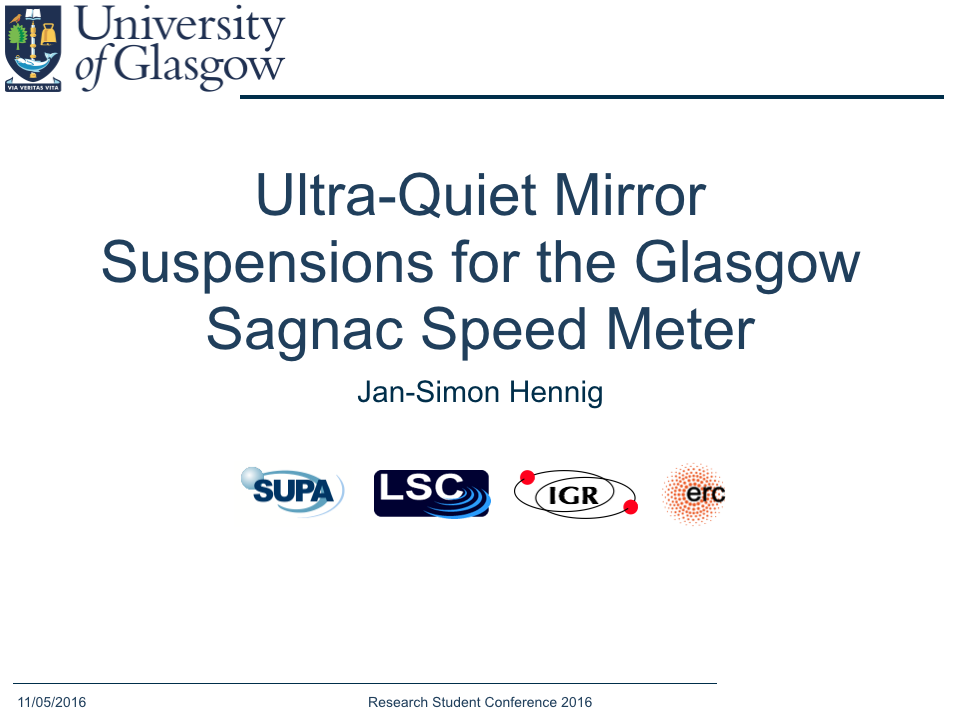
11/05/2016: And the winner is...
For the first time all (20) 3rd year talks have been given as a student organised "research conference" in one day. Speed meter PhD student Jan-Simon Hennig won this years best 3rd year progression talk which was given based on votes of participating students.
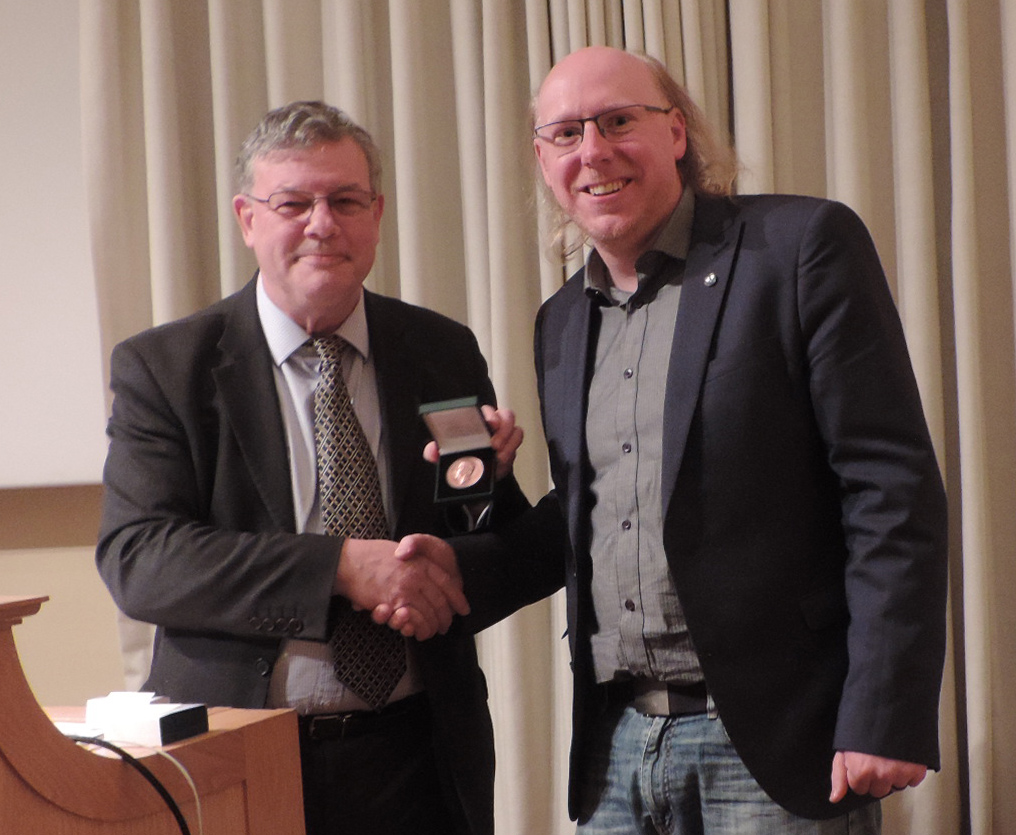
04/04/2016: RSE Medal
Just a bit more than one year after the official announcement, Ian Ritchie (RSE vice president business) presented Stefan Hild with the Sir Thomas Makdougall Brisbane Medal, the RSE's Early Career Prize for Physical, Engineering and Informatics Science Early Career Prize.
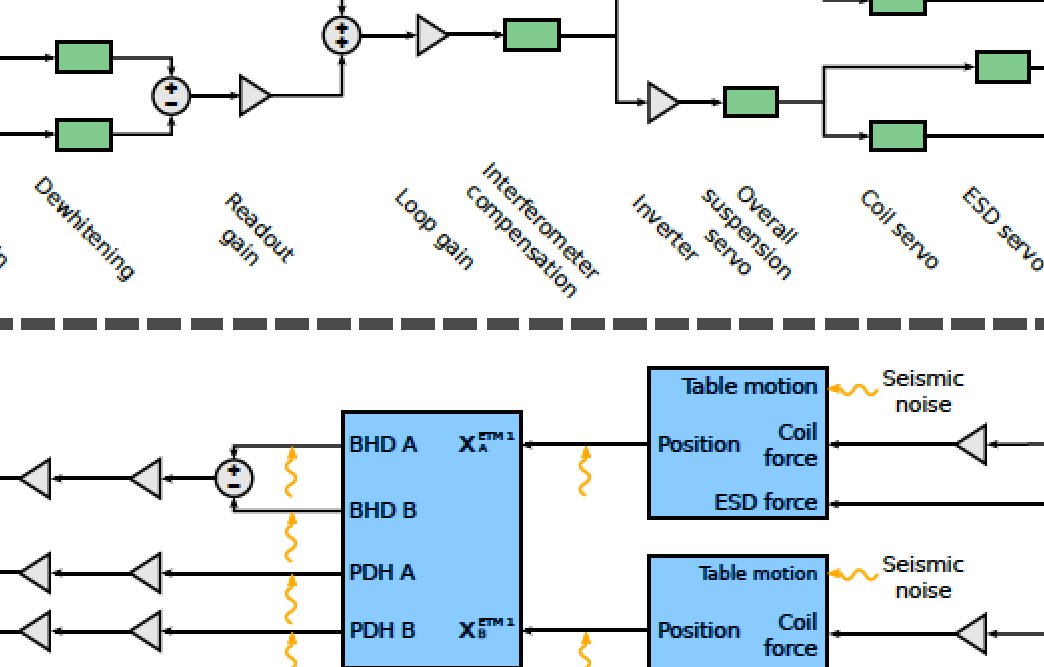
24/03/2015: New paper on how to control a speed meter
We have recently submitted for peer review a paper entitled "Control of a velocity-sensitive audio-band quantum non-demolition interferometer". In it we discuss one of the challenges associated with the speed meter: that it is sensitive to the cavity mirror velocity, and not the displacement (like a Michelson interferometer used for example in Advanced LIGO). Drifts in mirror positions due to noise such as seismic motion are not sensed strongly by the Sagnac speed meter, and so it cannot be controlled with only a velocity readout for long periods. We present a way to control these long term drifts by extracting a small displacement-proportional signal in addition to the main velocity readout. While we know this affects the sensitivity of the main velocity readout, we show in the paper that this technique does not have a significant impact on sensitivity if a suitable filter is used to blend the displacement and velocity feedback signals together. This technique allows the interferometer to be controlled for significantly longer periods. You can read the preprint version on arXiv.
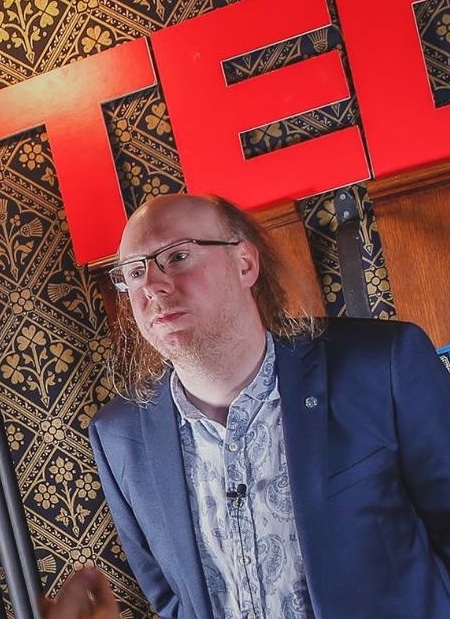
05/03/2016: TEDx talk on Gravitational Wave Discovery
At this years TEDx University of Glasgow event Stefan Hild was invited to speak about "Listening to the symphony of the Universe". In the end this resulted in quite a dense journey covering in just under 15 minutes everything from the workings of car suspensions, a world in which Mount Everest would only 1cm high up to colliding black holes. And obviously there was no way speedmeters could not have mentioned, too. It was a really exciting afternoon with very inspiring talks stretching from body confidence through pole dancing up to single photon cameras, and the gamification to change public reception of health. Watch the talk.
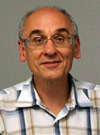
01/02/2016: Visit from the inventor of speed meters
It is a great pleasure to currently have Prof Farid Khalili visiting our group for a few weeks. He is one of the fathers of quantum measurements and one of the inventors of the speed meter concept. One of the many highlights of his visit and interaction with our group was investigating and discussing a new incarnation of the speed meter in a configuration which might be much more easily installed in current observatories such as Advanced LIGO than previously known speedmeter configurations. An article on this is in preparation.

25/09/2015: European Researchers' Night
As part of the European Researchers' Night half a dozen members of the speed meter team had set up a stall in the Glasgow Science Science for the 2015 Explorathon. With loads of exciting experiments, such as wave tank, real suspension of the speed meter experiment and a chladni plate, we were explaining to the visitors and in particular many children the physics of waves and in particular gravitational waves. It is always amazing to experience how interested the public is in our research! A few impressions of the evening from around the Science Center, featuring in particular our PhD student Jennie, can be found here.
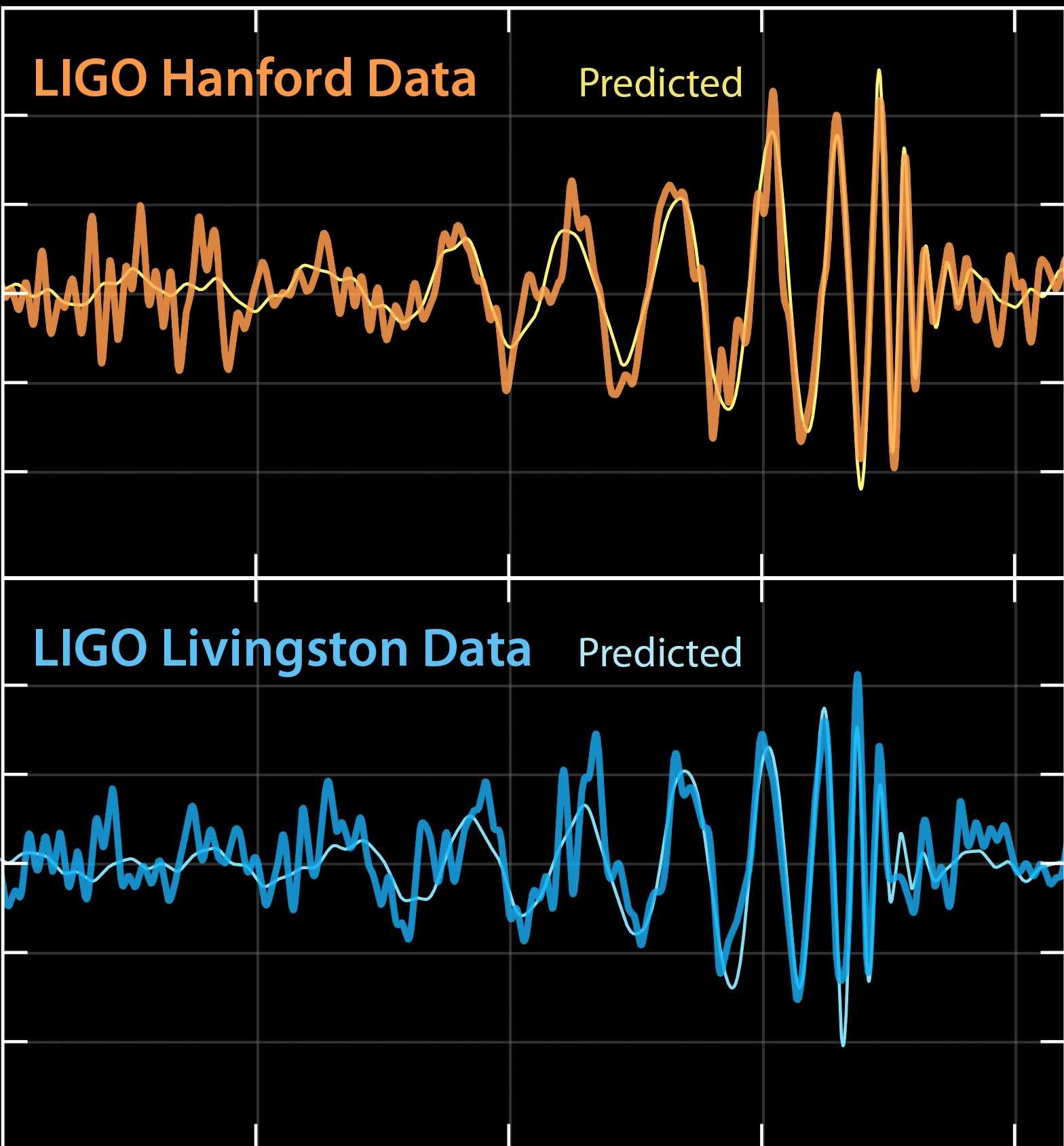
11/02/2016: Discovery of Gravitational Waves
On February 11th 2016 we shared some extremely exciting news with the world: we detected gravitational waves for the first time with the Advanced LIGO interferometers! Predicted to exist by Einstein one hundred years ago, it took a century of technological advances and scientific endeavour to realise gravitational wave detectors capable of sensing the minute strain of spacetime we expect to be produced by passing gravitational waves. As members of the LIGO Scientific Collaboration, we have worked with colleagues in the rest of the United Kingdom, the United States, Germany, Australia and many others around the world to create the most sensitive length measurement devices ever built: the Advanced LIGO observatories in Louisiana and Washington, United States. The discovery of gravitational waves has already allowed us to learn more about our universe, but we are only now scratching the surface of what's out there. There will no doubt be plenty of exciting discoveries in the future made by the LIGO Scientific Collaboration now that we can view the universe not only through light, but also through gravitational waves! In order to fully exploit the potential of unlocking the secrets of the Universe it is paramount to develop more sensitive gravitational wave detectors in future. Our work in Glasgow on the Sagnac Speedmeter concept will inform the design choice of future upgrades to Advanced LIGO and other gravitational wave observatories, such as the Einstein Telescope. Read more news stories regarding our group's work and the event on the main IGR page, see this blog post from speedmeter group member Sean Leavey and read the announcement paper and its companions for more information.

20/10/2015: Training the next generation
This year members of the speed meter team have completed a Marathon effort in teaching at summer schools to train the next generation of interferometry researchers. 1) Christian Graef and Stefan Hild have both given lectures at the 1st lecture weeks (April/May) of the GraWiton ITN in Pisa. 2) Sebastian Steinlechner and Stefan Danilishin went to Beijing in April for a KITPC/ITS-CAS "The Next Detectors for Gravitational Wave Astronomy" workshop and school. 3) Stefan Hild organised a combined lecture week in Crieff/Scotland of the International Max Planck Partnership (IMPP) and the International Max Planck Research School (IMPRS) at which Sebastian lectured. 4) Stefan Danilishin gave the quantum noise lectures at the IMPRS week on Mallorca in September. 5) Finally Stefan Hild gave a lecture on the speed meter concept at the Les Houches Summer School: Quantum Optomechanics and Nanomechanics.
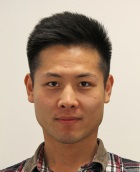
1/10/2015: New Ph.D. student
Teng Zhang who is from China has just joined the interferometry group as a PhD student funded via the College of Science and Engineering scholarship scheme. He did his undergraduate in astronomy in Beijing Normal University in China. His current project is on the Quantum Non-demolition readout system for sagnac speedmeter.
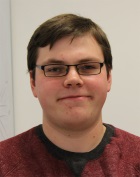
1/10/2015: New Ph.D. student
Andrew Spencer has joined the group as a PhD student after completing an undergraduate degree in Physics at the University of Glasgow. Having previously completed his 4th year project and summer student project and his Master project with the speedmeter team, he will now start investigating speed meter arm cavity designs based on polarising optics with a view towards building 10m speedmeter in the Glasgow prototype interferometer.
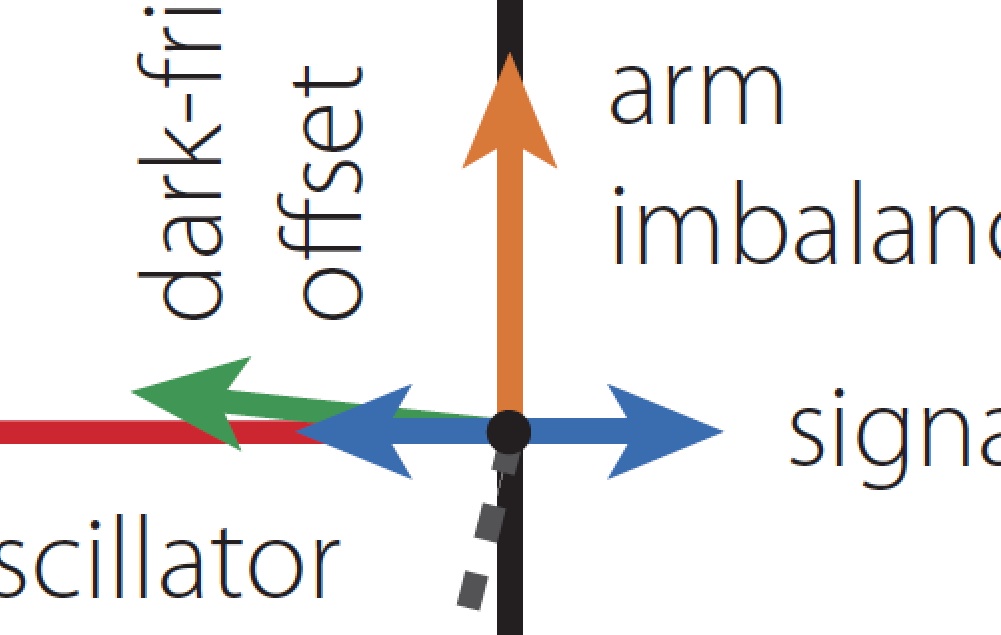
14/6/2015: New Article on Balanced Homodyne Readout for Future Gravitational Wave Detectors
Balanced homodyne detection, providing a flexible readout of the full amplitude- and phase-quadrature space of the output light field, is generally expected to replace the currently used DC readout. Up to now, little investigation has been undertaken into how balanced homodyne detection can be successfully transferred from its ubiquitous application in table-top quantum optics experiments to large-scale interferometers with suspended optics. In our article we derive implementation requirements with respect to local oscillator noise couplings and highlight potential issues with the example of the Glasgow Sagnac Speed Meter experiment, as well as for a future upgrade to the Advanced LIGO detectors.
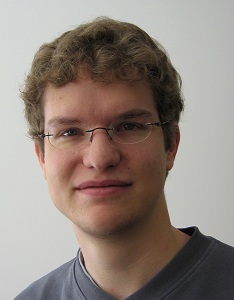
27/5/2015: Marie Curie Fellowship
Sebastian Steinlechner has been awarded a Marie Curie Fellowship for his research on "Advanced Quadrature Sensitive Interferometer Readout for Gravitational Wave Detectors". This will allow him to continue his work on readout and control of the Sagnac Speed Meter experiment.

14/5/2015: Preparation of auxiliary suspension parts
Over the past few weeks we made great progress in preparing the parts for the auxiliary suspensions. For the use in an ultra high vacuum environment it is required to clean all parts thoroughly. This is done by using an ultrasonic bath with detergent. Afterwards the parts are heat treated for 48 hours. After the coming week we should have all parts cleaned, baked and ready for assembly.

14/5/2015: New coil winding machine
For the winding of coils a new winding machine has arrived. The machine from CNCdesign ltd will help winding the coils used for the coil-magnet actuators used for local control of our suspensions.
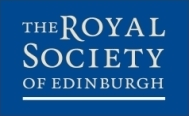
30/3/2015: RSE Sir Thomas Makdougall Brisbane Medal
The Royal Society of Edinburgh has awarded the RSE/Sir Thomas Makdougall Brisbane Medal, its Physical, Engineering and Informatics Science Early Carrer Prize to Stefan Hild. For more details please see the press release of the Royal Society of Edinburgh or this news item of the University of Glasgow.

1/2/2015: Global Young Academy
Dr Stefan Hild has been appointed to the Global Young Academy. As the voice of young scientists around the world the Global Young Academy provides a rallying point for outstanding young scientists from around the world to come together to address topics of global importance and the role of science in creating a better world. The 200 members, are leading young scientists from 58 countries and all continents. Members are selected for the excellence of their science and their commitment to service and are serving five-year terms.
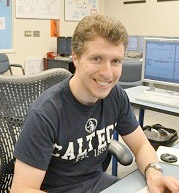
1/2/2015: Welcome for a new group member
We are very happy to welcome Dr Stefan Danilishin as new member in our team. Originally from Moscow state University (working with Braginsky and Khalili), Stefan has been an Alexander von Humbold fellow at the Max Planck Institute for Gravitational Physics (working with Yanbei Chen), and then moved to the University of Western Australia, before joining us in bonnie Scotland.
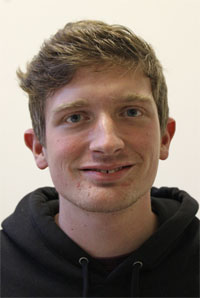
3/12/2014: New master students from Hannover University
Today Andreas Glaefke from the University of Hannover started his master project with us. For the next 12 months Andreas will look into various aspects related to reading out position or speed of test masses and how to best combine them to achieve optimal sensitivity.
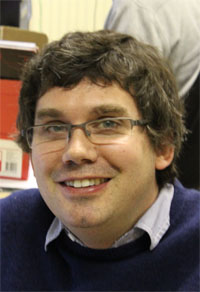
1/12/2014: How flat can you make the surface of mirror?
This was one of the questions we tried to answer with the help of Dr Jerome Degallaix from the Laboratoire des Matériaux Avancés in Lyon, who was visiting for a few days. Together we worked on the mirror specifications for our Sagnac speed meter proof of principle experiment and of course we also learnt lots of useful tricks for OSCAR
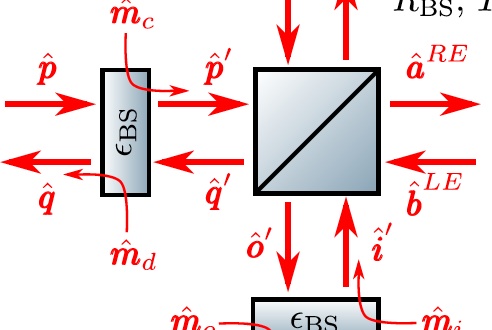
15/11/2014: New model for quantum noise in speed meters featuring realistic mirrors
Dr. Stefan Danilishin from the University of Western Australia was visiting us again for a few weeks. This gave us the opportunity to finish our development of quantum noise models for Sagnac speed meters featuring assymmetric optics. This brings us one step closer towards realistic Sagnac speed meters, using real mirrors with imperfections! The corresponding article "Quantum noise of non-ideal Sagnac speed meter interferometer with asymmetries" can be found here.
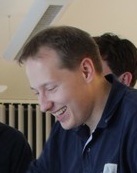
27/10/2014: Visitor from Germany to work with us on novel design for electro-static drives
Following last weeks speed meter workshop, Holger Wittel from the Albert Einstein Institute in Hannover stayed on for a few days. Over the past few years we have worked together with Holger on the evaluation of a novel design for electro-static drives (ESD). The new geometry, which provides a significantly reduced coupling of seismic noise, was orginally developed in the context of the AEI-10m prototype. As it turns out our novel ESD concept has an even higher potential for the application to our 1g mirrors in the speedmeter experiment. The article on the concept is now available at the arxiv (1411.3853).

21/10/2014: First International Sagnac Speed Meter Workshop
What is the recipe for a successful workshop? Ours was to invite seventeen international experts in laser interferometry to work on Sagnac speed meters in one of Scotland's most beautiful national parks. In two extremely productive days we answered open questions about various aspects, e.g. quantum noise modelling, suspension design, feedback control and balanced homodyne readout in our experiment. Thanks to the great atmosphere, the friendly staff at SCENE and the inspiring views over Loch Lomond everyone agreed that we should definitely come back soon for a second workshop!
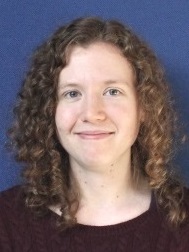
1/10/2014: New Ph.D. student
Jennifer has just joined the wider Interferometry group as a PhD student. She did her undergraduate in Astrophysics in the School of Physics and Astronomy at Glasgow, where she completed several projects in the IGR. Her work is currently on Optical Springs but she will join the Speedmeter group later in the project.
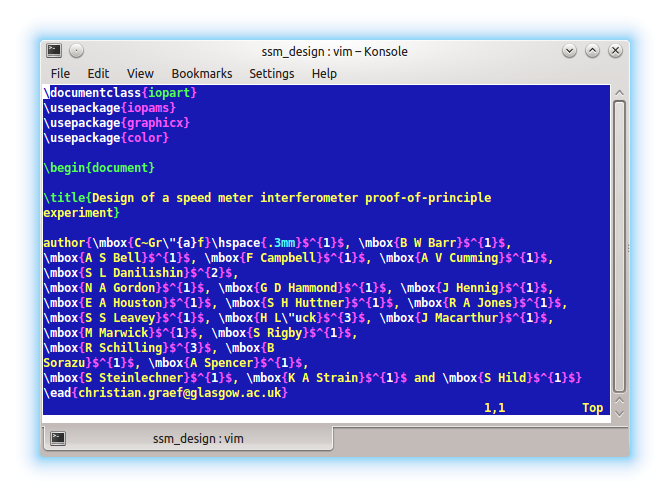
9/9/2014: Sagnac Speed Meter design published
Our paper with the title "Design of a speed meter interferometer proof-of-principle experiment" was accepted by the peer-reviewed journal "Classical and Quantum Gravity" and will be published (publication page) in one of the forthcoming issues. In the mean time, feel free to have a look at the latest version of the manuscript on the arXiv pre-print server.
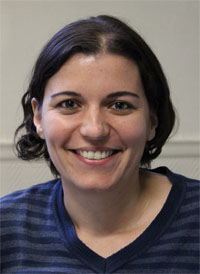
1/9/2014: New Ph.D. student
Reinforcements from Italy have arrived. Daniela Pascucci is starting as a PhD student on the Speedmeter proof-of-principle experiment. She earned a Masters degree in Astrophysics at the University of Naples "Federico II", where she has worked in the Advanced Virgo project 'Interferometric measurement of the quality factor for test masses of Virgo'.

26/8/2014: Speedmeter work presented at conference at Stanford University
Several members of the speedmeter have given talks the LIGO Virgo collaboration meeting at Stanford University near San Francisco. The Glasgow interferometry team presented four talks directly relevant to our speedmeter work plus two more talks and one poster on other advanced interferometry topics.
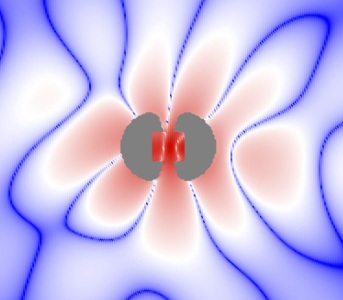
2/5/2014: Visitor from Italy to work with us on a new method to reduce gravity gradient noise
This week we had Jan Harms from Urbino visiting. Though Jan has quite some expert knowlegde on quantum noise matters, this visit was dedicated to explore an new idea to reduce gravity gradient noise. The results of one week of hard thinking are now written up in article available on the arxiv (http://arxiv.org/abs/1406.2253). Perhaps this concept could be beneficial for implementation in a future LIGO-India detector?
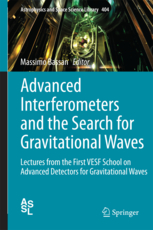
8/4/2014: Book on Advanced Gravitational Wave interferometers published
The lecture notes from the VESF summer school held in 2012 at Virgo in Pisa have finally been published as a book: "Advanced Interferometers and the Search for Gravitational Waves". Amongst other interesting topics this book includes a chapter by Stefan giving "A basic introduction to quantum noise and quantum-non-demolition techniques" and a special chapter on ET written by Michele, Mark and Harald.

24/3/2014: Isolation stacks installed
Today, with united forces, we finalised the installation of our two in-vacuum seismic isolation stacks, consisting of four alternating layers of 60kg stainless steel mass elements and "high-tech rubber" cylindrical fluoroelastomer springs. Thanks to five pairs of helping hands things worked out as smoothly as one could have imagined.
Sufficient seismic isolation is crucial to reach the sensitivity goal of our Sagnac Speed Meter interferometer. With our shiny new isolation stacks we'll be able to attenuate seismic disturbances by more than 60dB at frequencies above 200Hz. This reduces the complexity our optics suspension designs which would otherwise need to provide all seismic isolation by themselves!
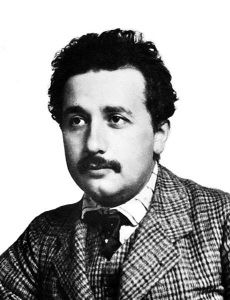
17/3/2014: Cosmic Microwave background measurement suggests the presence of premordial gravitational waves
Observations by the south pole telescope published today (see full article here) support not only the theory of inflation of the very early Universe, but also give strong evidence for the existence of gravitational wave a short time after the Big Bang. This is really excellent news! Though this is not quite the start of gravitational wave astronomy, it give us a already a taster of what we can learn from gravitational waves in future. For sure there will be more exciting science coming from gravitational waves, than just confirming the theory of general relativity or doing the first direct detection. (eLISA news release, GEO600 news release)
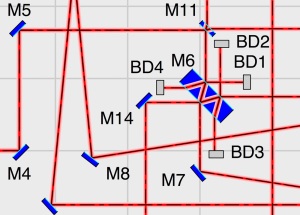
13/3/2014: Our Optical Layout is taking shape
As it turns out it is not so easy to squeeze 15 suspended optics into one vacuum tank with a diameter of 1 meter. However, after some weeks on the drawing board, shifting mirrors and laser beams all over the place and creating new versions of the optical layout on a daily basis, we believe we have now found and settled on a manageable configuration of our optical layout. This version called 1.0 provides all the features for the main interferometer and in vacuum readout we need. Let's see when version 1.01 becomes necessary.
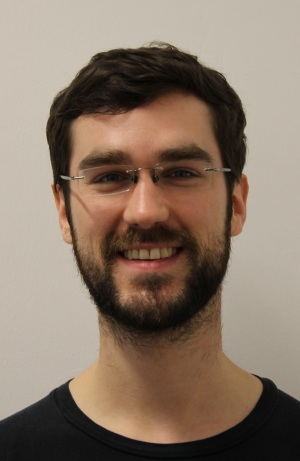
01/2/2014: New PhD student arrived
Jan-Simon Hennig, a former Masters student from the AEI in Hanover is starting as a PhD student on the speedmeter experiment. During his studies in Hanover he was performing measurements on the non-reciprocal phase noise of fibres in a LISA related experiment. He also worked within the LISA optical bench team in collaboration with Glasgow University.
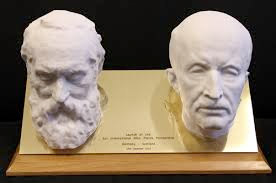
19/12/2013: Launch of the first "International Max Planck Partnership" (IMPP)
Today the first "International Max Planck Partnership", a multi-million pound partnership between 5 Scottish Universities and 5 of the German Max Planck Institutes is launched. The research focus will be 'Measurement and Observation at the Quantum Limit' (MOQL), such as our speedmeter work.

28/10/2013: New Humboldt Fellow arrived
Dr. Sebastian Steinlechner from AEI Hannover starts today his Feodor Lynen Fellowship, funded from the German Humboldt Foundation in conjuction with the International Max Planck Partnership between Scotland and Germany.
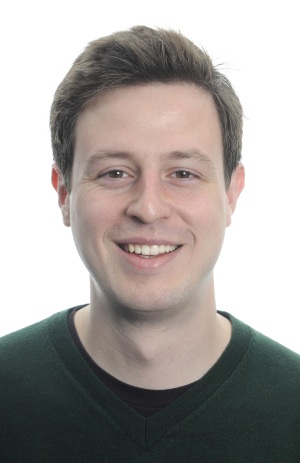
1/10/2013: New PhD student starting
Alasdair Houston is starting as PhD student on the speedmeter experiment. After a few years of building lasers for Coherent it is now time to go back to research.

30/9/2013: More Theoretical Support
Prof Stefan Danilishin from the University of Western Australia has returned once more to Scotland to help with the design of the speedmeter experiment.

17/6/2013: Visitor from the University of Western Australia
Prof Stefan Danilishin from the University of Western Australia, (formerly working with Braginsky and Khalili at Moscow) is visiting us for the next two weeks to help refining the quantum noise modelling of our speedmeter.

2/4/2013: New Postdoc starts
Christian Graef, who has worked for his PhD studies at the AEI-10m prototype interferometer has started today. He will be working full time on the speed-meter experiment. With his excellent expertise in optical design, simulations, control and squeezing he is ideally suited for constructing our Sagnac speed-meter.
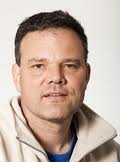
26/3/2013: Visitor from AEI-Hannover
This week Harald Lueck from AEI Hannover who is one of the key people in the GEO 600 team as well as the deputy scientific leader of the ET efforts, is visiting Glasgow to discuss ideas and interesting concepts regarding the speed-meter concept.
21/3/2013: New Article on Polarization Sagnac Interferometer
Our colleagues from the University of Birmingham have just uploaded an interesting article onto the arXiv: M. Wang et al, "A realistic polarizing Sagnac topology with DC readout for the Einstein Telescope".
18/3/2013: Speed-meter Presentation in Washington D.C.
We presented our speed-meter concept for the first time to the quantum noise experts to the LIGO and Virgo collaborations at the March LVC meeting in Washington D.C.
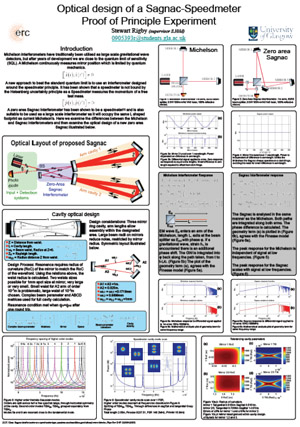
7/3/2013: Speed-meter Student wins Poster Prize
Stewart Rigby who is doing his Bachelor work on the optical design of the speed-meter interferometer won the prize for the best project poster of all project students within the School of Physics and Astronomy at the University of Glasgow. Congratulations, Stewart. This is well deserved. By the way Stewart is now the proud owner of a brand new copy of the Feynman lectures!

4/12/2012: Presentation at ET Symposium
We presented our experimental for the speed-meter proof of principle experiment at the ET Symposium at the Albert Einstein Institute Hannover, Germany. This was the very first public presentation on the speed-meter experiment.
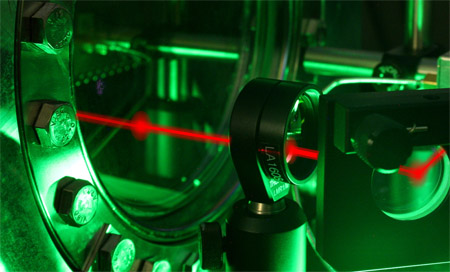
20/9/2012: First Student Projects
Today two Bachelor students started their research projects on the speed-meter. Stewart Rigby will work the optcial design of the high-finesse arm cavities of the speed-meter and analytically investigate the transfer functions of Michelson and Sagnac interferometers. Fraser Campbell will set up the new laser and the corresponding input optics.
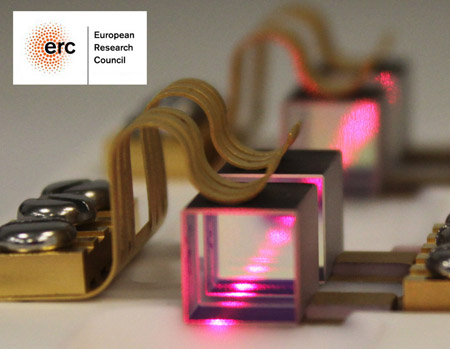
1/9/2012: Project Start
The ERC Starting grant is officially starting today. The University obtained already the first installment of a few 100k€. From now we 1828 days left to prove the speed-meter concept!
For more information, please contact Stefan Hild.
